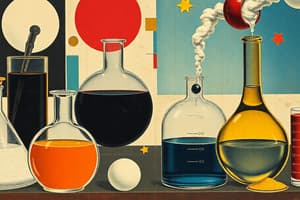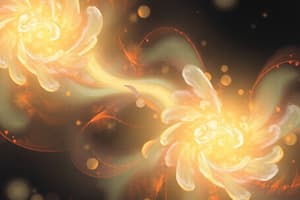Podcast
Questions and Answers
Which of the following statements accurately describes the behavior of gas particles when pressure is increased?
Which of the following statements accurately describes the behavior of gas particles when pressure is increased?
- Gas particles move slower and occupy more space.
- Gas particles move faster and occupy less space. (correct)
- Gas particles move slower and occupy less space.
- Gas particles move faster and occupy more space.
At what temperature does a liquid transform into a gas?
At what temperature does a liquid transform into a gas?
- Freezing point
- Any temperature below the boiling point.
- Melting point
- Boiling point (correct)
Which state of matter has the highest density?
Which state of matter has the highest density?
- Solid (correct)
- Plasma
- Gas
- Liquid
What is the primary reason that liquids take the shape of their container?
What is the primary reason that liquids take the shape of their container?
How does the kinetic energy of particles change during the condensation process?
How does the kinetic energy of particles change during the condensation process?
What is the primary difference between evaporation and boiling?
What is the primary difference between evaporation and boiling?
What happens to the volume of a gas when the temperature is increased?
What happens to the volume of a gas when the temperature is increased?
Which statement accurately describes the arrangement of particles in a solid?
Which statement accurately describes the arrangement of particles in a solid?
Flashcards
Properties of Solids
Properties of Solids
Have a fixed shape and volume, incompressible, high density. Particles tightly packed with strong attraction.
Properties of Liquids
Properties of Liquids
Fixed volume but take shape of container, less compressible, lower density than solids. Particles can move past one another.
Properties of Gases
Properties of Gases
No fixed shape or volume, highly compressible, low density. Particles are far apart and move freely.
Melting
Melting
Signup and view all the flashcards
Boiling
Boiling
Signup and view all the flashcards
Effects of Temperature on Gas Volume
Effects of Temperature on Gas Volume
Signup and view all the flashcards
Effects of Pressure on Gas Volume
Effects of Pressure on Gas Volume
Signup and view all the flashcards
Kinetic Particle Theory
Kinetic Particle Theory
Signup and view all the flashcards
Study Notes
States of Matter: Solids, Liquids, and Gases
-
Solids:
- Shape: Fixed shape
- Volume: Fixed volume
- Compressibility: Incompressible
- Density: High
- Particle Arrangement: Tightly packed in a regular pattern, vibrating around fixed positions
- Intermolecular Forces: Strong forces of attraction between particles
-
Liquids:
- Shape: Takes the shape of its container
- Volume: Fixed volume
- Compressibility: Less compressible than gases
- Density: Lower than solids
- Particle Arrangement: Closely arranged, but particles can move past one another in a random arrangement
- Intermolecular Forces: Weaker forces of attraction than solids
-
Gases:
- Shape: No fixed shape
- Volume: No fixed volume, fills the container
- Compressibility: Highly compressible
- Density: Low
- Particle Arrangement: Particles are far apart and move rapidly in all directions
- Intermolecular Forces: Negligible forces of attraction
Changes of State
- Melting: Solid to liquid; occurs at the melting point with heat absorption
- Boiling: Liquid to gas; occurs at the boiling point with heat absorption
- Evaporation: Liquid to gas; occurs at any temperature below boiling point with heat absorption
- Freezing: Liquid to solid; occurs at the freezing point with heat release
- Condensation: Gas to liquid; occurs at the boiling point with heat release
Effects of Temperature and Pressure on Gases
- Temperature:
- Increase in temperature = increase in kinetic energy of gas particles = increase in volume
- Decrease in temperature = decrease in kinetic energy of gas particles = decrease in volume
- Pressure:
- Increase in pressure = decrease in volume (particles forced closer together)
- Decrease in pressure = increase in volume (particles can move further apart)
Kinetic Molecular Theory and Gas Behavior
- Heating: Adding heat increases kinetic energy of particles, causing changes in state from solid to liquid or liquid to gas
- Cooling: Removing heat decreases kinetic energy of particles, causing changes in state from gas to liquid or liquid to solid.
- Kinetic Molecular Theory on Gas Behavior:
- Temperature: Higher temperature leads to faster particle movement and larger volume.
- Pressure: Increased pressure leads to smaller volume and vice versa.
Studying That Suits You
Use AI to generate personalized quizzes and flashcards to suit your learning preferences.




